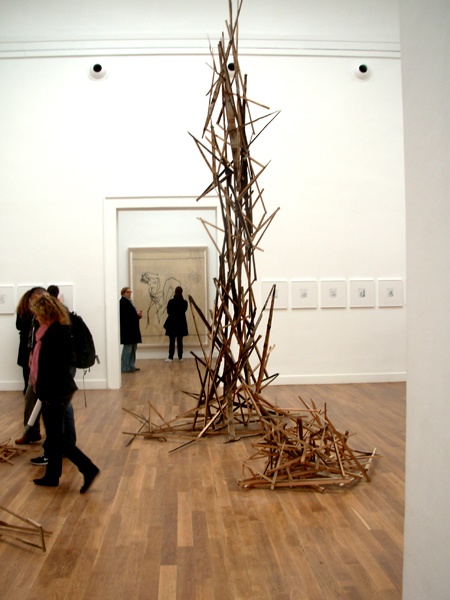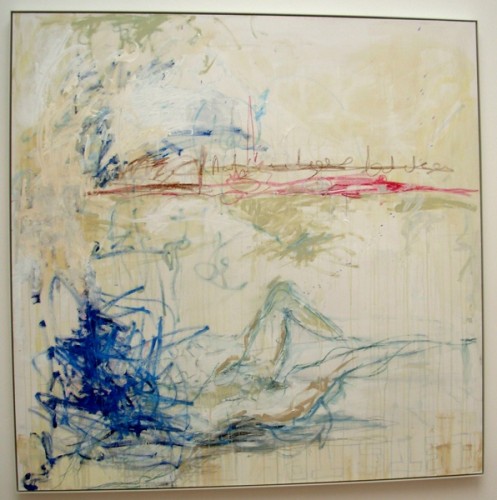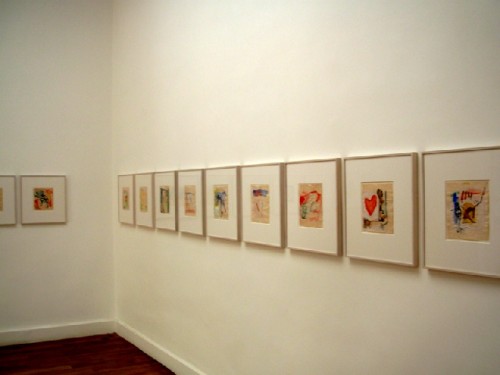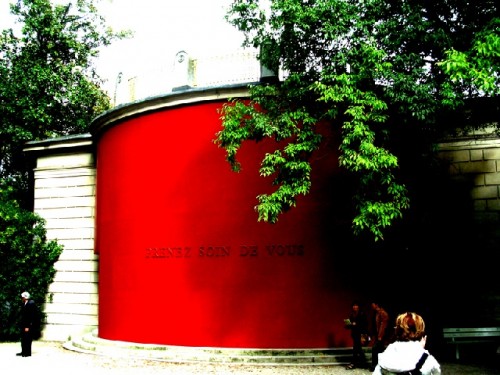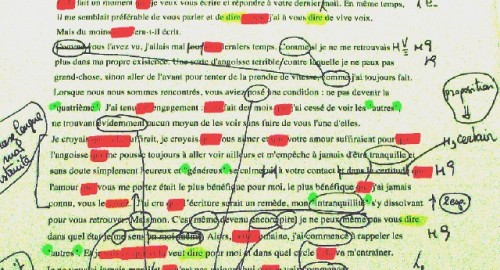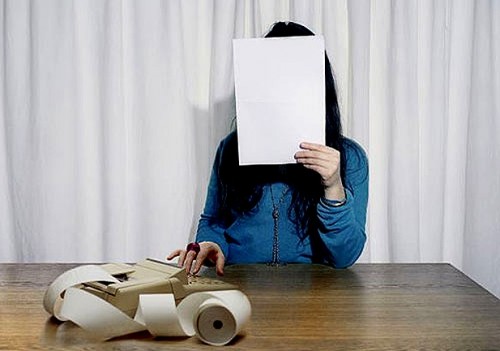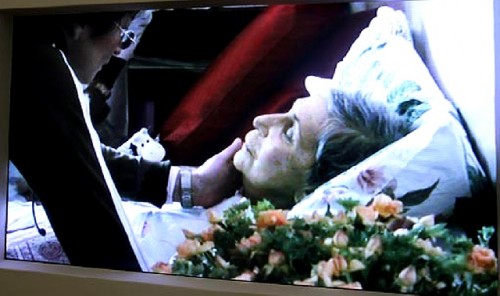Venice Bienalle 2007: Tracey Emin and Sophie Calle
A Tale of Two Cities
By: Charles Giuliano - Nov 17, 2007
Touring the national pavilions in the Giardino of the Venice Biennale creates the unique sense of some kind of competition. There is the feeling evoked of an Olympic Games for the visual arts. Since the notion of permanent national pavilions was established when the series of exhibitions was founded in 1895 it is inevitable that some of the prime locations would be taken in this precious real estate by the dominant Western powers. The only African nation so represented appears to be Egypt and the first South American nation to have its own permanent building was Venezuela. In the current version of the Biennale, which ends in a couple of weeks, there are other pavilions now occupying temporary spaces scattered all over the city. We managed to see just a few of them most notably pavilions for Australia and Singapore which were located near the Academia Bridge.
The array of national pavilions evokes a frenzy of flag waving and inevitable jingoism. Which from a marketing standpoint, with its element of spectacle, may not be such a bad idea. Perhaps, in the future, they might have a televised event in which all of the participating artists are suited up, as is the case with the Olympics, and then march into a great stadium, with the appropriate music and fireworks, each carrying the flag of their nations. And that winners step to a three tiered podium to be awarded gold, silver and bronze medals in a variety of categories such as: Painting, Sculpture, Installation, Video, Photography, Performance, Grunge, etc.
Stepping into some of the minor national, not quite Third World, pavilions one encountered work that was comparable to the performance of say, the Jamaican Bobsled Team, at a sports event. We were viewing the work for no reason other than that it got grandfathered in because it occupied a permanent building. Conversely, there were certain expectations that one would see more credible and important work in the pavilions of nations which are more established in the mainstream of the global art world. This did and didn't prove to be the case. It is difficult to decide which exhibition I found to be more irrelevant, David Altmejd, representing Canada, or Isa Genzken, in the German pavilion. As always, I much appreciated the paintings of Herbet Brandl in the Austrian pavilion. He is a wonderful painter and these newest works were more abstract and free than the epic scaled mountain views he showed at Mass MoCA in an Austrian exhibition a couple of years ago, or the works I saw before that in his Vienna studio. But here the paintings appeared to be just lost in the tidal wave of art on view. Nobody appears to have made much of a fuss over them and, as usual, more ink was spilled on fellow Austrian, Franz West, and his typically bloated organic forms in the Arsenale.
So it goes when one bobs and weaves through such an onslaught of material with the challenge of sorting out the difference between forest and trees. Particularly when back home and removed from the field trying to pull together notes, images and fleeting impressions of faulty memory.
In this essay we focus on the French and British pavilions. Of course Britain and France have been traditional rivals and combatants down through the centuries dating back to the Battle of Hasting in 1066, when Harold, the British king, got an arrow through the eye and the Norman king William conquered and allegedly Francophiled the tight little island. Henry V of course got a bit of pay back on October 25, 1415, Saint Crispin's Day, during the battle of Agincourt. His archers wiped out the charging French knights and took the field. On every level, from football to art, they have been knocking heads across the channel so why not take that spirit to Venice?
What makes this competition the more intriguing is that both pavilions are devoted to the work of a single woman artist. Further, feminist issues are conveyed in their approaches. In the case of Tracey Emin (born 1963), for Great Britain, raw sex in its most physical and smarmy manifestation as usual from one of the Bad Girls of Young British Art. Representing France, Sophie Calle, born a decade earlier in 1953, in a conceptual response to the pain of romance and rejection.
In the case of Tracey Emin her reputation preceded her. Surely there can be no other explanation as to why she is being so honored for an installation of work that never focuses and congeals beyond its bits and pieces of disparate elements. These include a knocked together bunch of pickup sticks passed off as sculpture, a selection of quick little erotic water colors and prints, some pathetic spread leg paintings of her pussy in the ersatz manner of Egon Schiele with a nod to Anselm Kiefer, and the more interesting texts in script created in neon, and pieces of sewing and appliqué.
In the British pavilion the parts did not add up to much of a whole. Initially I just breezed through the show with little or any response. Only upon emerging and learning it was a Tracey Emin installation did I return for another look. This is an artist whom, like most Americans, I first became aware of in 1999-2000 when "Sensation" a selection from the collection of Charles Saatchi was shown, with great controversy, at the Brooklyn Museum. Her contribution to that exhibition "Everyone I Have Ever Slept With, 1963-1995" was a tent in the interior of which were appliquéd the names of friends and family members to lovers. That piece like others was lost when a 2004 fire ravaged a warehouse in which they were stored.
Her importance in the pantheon of contemporary British art, and its six figure plus evaluations for the best examples, is beyond debate. Significantly, in 2007 she was voted in as an Academician of the Royal Academy of the Arts and Sciences an institution founded by George 111. Again, that is so British. They like to put titles and medals on the heads and chests of their leading artists and scientists. Like Sir Elton John and Sir Paul McCartney. Perhaps one day Lady Tracey Emin or Lord Johnny Rotten. The Brits really go for all that royal stuff. Tracey Emin, in this case, after Rachel Whiteread, (1997) is only the second woman to represent Great Britain at Venice. It seems inevitable, if you follow the drift, that Sarah Lucas will get her shot at the pavilion. Arguably, Emin was honored at Venice more on past work and life achievements than the relevance of her work at this moment in time.
The best way to kill the driving force and creative spirit of an interesting artist is to throw titles and medals at them. It only seems to confuse and diffuse their work. For Emin the pressure of picking up and running with the flag was too much for her. Particularly when the basic premise of her art has been an out of control bad girl having a drunken meltdown on live TV. It's a bit difficult to pull off such moments while balancing a tiara. So the spectacle of a spread legged member of the Royal Academy jerking off in Venice is forced and absurd. For her own sake arguably she needs rehab and therapy more than medals. You go girl.
After a brawly pub crawl through the British pavilion how deliciously Gallic the exhibition by Sophie Calle proved to be. Her work first came to my attention when Milena Kalinovska brought it to the Institute of Contemporary Art in 1990. It was one of the most absorbing projects of her tenure which often presented work by women artists. Like Emin this exhibition by Calle focuses on women and their issues but with enormous charm, diversity, and wit.
The premise of the show is the artist's response to a "Dear John" or in this case "Dear Sophie" letter from a lover who wishes her a fond farewell. The e mail ends with the words (translated from the original French) "Take Care of Yourself." Instead of getting mad the artist gets even by making this the focus of her exhibition. We are shown the original text greatly enlarged but never learn the identity of its author.
Quoting a wall text in the exhibition Calle informs us that "I received an e mail telling me it was over. I didn't know how to respond. It was almost as if it hadn't been meant for me. It ended with the words 'Take care of yourself.' And so I did. I asked 107 women, chosen for their profession or skills, to interpret this letter. To analyze it, comment on it, dance it, sing it. Exhaust it. Understand it for me. Answer for me. It was a way of taking the time to break up. A way of taking care of myself."
The results of the project cover an enormous range of media from text, video and photography, as well as moods from poignant, enraged, hilarious, to detached and analytical. It was entirely absorbing and in the context of trying to deal with such an enormous and sprawling event one's real regret is not having more time to linger over and absorb its every detail.
While with Emin's project was about raw, slutty sex, for Calle, the focus is on aspects of romance. It evoked all those French movies about relationships with their process of love and betrayal. The French have developed affairs into their national pastime and greatest art form. Calle's work conveys all of those sophisticated and witty nuances. It is feminist work for men too. I found myself no less involved and fascinated than arguably a woman would be. It was simply delightful, riveting and fun.
The Calle exhibition left me with a longing to be back in Paris or to indulge in a glut of French movies; have a crossiant and café au lait; flirt and gossip; accessorize. Calle is one of the best conceptual artists working today. There is such wonderful nuance that she brings to even the toughest topic. In another part of the Bienalle, in the Arsenale is another such work. It is about the fact that on the day that she learned of being selected to represent France she was given the news that her mother had but a month to live. She turned these last moments into a work of art in the form of a poignant video recording her mother's final moments. How strange and powerful to turn such a difficult experience into a work of art. It is a testament to her courage and toughness as well as her inspiration and originality as an artist. What a woman.


